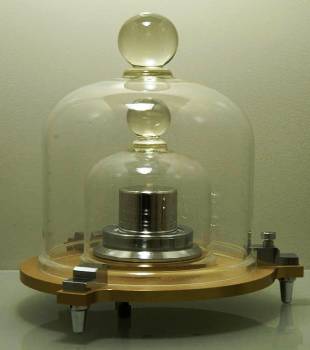The Kilogram Has Excess Mass, Could Cause Scientific Havok
There is concern that the original kilogram does not represent the mass of the original kilogram anymore.
The kilogram is one of seven International System of Units (SI) of measure and is defined by the International Prototype kilogram (IPK) which is a right-circular cylinder made of 90 percent platinum and 10 percent iridium that is stored at the Bureau International des Poids et Mesures in Sèvres, France.
40 replicas were made in 1884 and sent around the world in an effort to standardize the measure of mass. Scientists at Newcastle University in the UK now said that UK's replica number 18, which is stored at the National Physical Laboratory (NPL) has changed its mass since 1884 by "tens of micrograms" due to the accumulation of hydrocarbons.
Research lead Peter Cumpson, professor of Micro Electro Mechanical Systems at Newcastle University, said that "mass is such a fundamental unit that even this very small change is significant and the impact of a slight variation on a global scale is absolutely huge." He noted that "there are cases of international trade in high-value materials - or waste - where every last microgram must be accounted for."
Cumpson said he used an x-ray photoelectron spectroscopy machine (XPS) to analyze the IPK's surface and found that a "suntan" could remove the excess weight again. According to the scientist, the "carbonaceous contamination" could be correct by exposing the surface to "a mixture of UV and ozone", which would not damage the platinum surface of the cylinder.
Newcastle University said that "work is underway internationally in several National Measurement Institutes to find an alternative to the IPK – a standardised value for the kilogram that is not based on a matchbox- sized piece of metal." However, until such a replacement is found, scientists have to make sure that the kilogram remains a kilogram: "If the kilogram does put on weight then it's imperative that we understand exactly how the IPK is changing," Cumpson said.
Contact Us for News Tips, Corrections and Feedback
Get Tom's Hardware's best news and in-depth reviews, straight to your inbox.

Wolfgang Gruener is an experienced professional in digital strategy and content, specializing in web strategy, content architecture, user experience, and applying AI in content operations within the insurtech industry. His previous roles include Director, Digital Strategy and Content Experience at American Eagle, Managing Editor at TG Daily, and contributing to publications like Tom's Guide and Tom's Hardware.
-
cats_Paw Oh my god! A kilogram cilinder that noone cares about now is 10 micrograms smaller, how can we ever live with this?!Reply
And really, do they even use that thing?
Its a funny trivia no doubt, but science news? -
manofchalk BaxtergateAbolish mass now! L Ron Hubbard has frequently been critical of these unelected eggheads dictating their nonsense to us. Scientology is the true way forward, and will abolish this nonsense, and set you on the bridge to total freedom!I suppose Xenu will have a faultless unit of mass waiting when we arrive?Reply
The near-universal unit of Mass is slightly off, that cant be good. Dont suppose it could as simple a fix of making a set of scales accurate enough to record exactly 1kg, then just using that as a template to make more of these? -
yeungl Since mass cylinder is a master of standard, how can we use less accurate instrument to calibrate the master standard. That violate the fundamental rule of metrology.Reply
If the calibration is performed with more accurate standard, why not we switch to the better one? -
brianvan wait, there are 40 replicas! So just use one of the other 39 in the meantime! Why would we make a big deal of this? That's why we have redundant standard units. I'm going to hold my panic for now.Reply -
w1zz4 cats_Paw : It's heavier not lighterReply
yeungl : They didn't weight it, they look at it with a microscope and found new hydrocarbon depot which certainly effect it's original mass.
-
xpeh BaxtergateAbolish mass now! L Ron Hubbard has frequently been critical of these unelected eggheads dictating their nonsense to us. Scientology is the true way forward, and will abolish this nonsense, and set you on the bridge to total freedom!Reply
lol -
LORD_ORION I was hoping for something more interesting... like the mass of platinum, everywhere, was mysteriously changed by unknown forces in the universe.Reply
